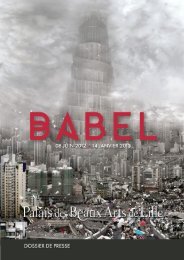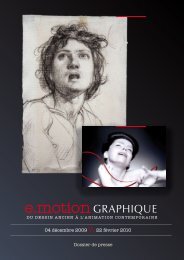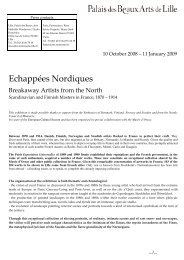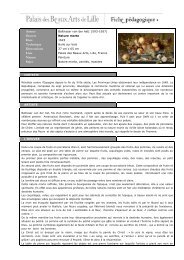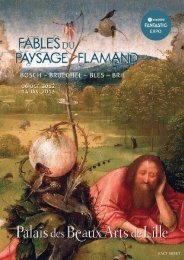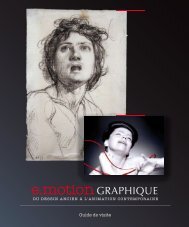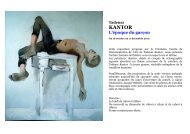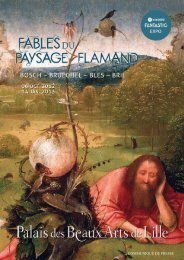PRESS KIT - Palais des Beaux Arts de Lille
PRESS KIT - Palais des Beaux Arts de Lille
PRESS KIT - Palais des Beaux Arts de Lille
You also want an ePaper? Increase the reach of your titles
YUMPU automatically turns print PDFs into web optimized ePapers that Google loves.
Lucas van Valkenborg<br />
Landscape with Mines<br />
Paris, Ne<strong>de</strong>rlands Intituut Fondation Custodia, Institut néerlandais/ D.R.<br />
In the middle of nature and a framework of harmonious elements, the cosmological<br />
dimension <strong>de</strong>als with the resemblance between the human and the divine. With the<br />
contribution of traditional myths, both profane and sacred, abundance in all domains is<br />
noticeable. Breughel and Paul Bril created visionary landscapes, using the inversion<br />
method appreciated by Flemish mannerists. Marvellous landscapes, often with religious<br />
themes, offer a whole different range of feelings. They are not as close to daily life, more<br />
elliptical, but just as fascinating to the spectator. The religious scenes are submerged in<br />
panoramic landscapes full of realistic <strong>de</strong>tails, which reflect the diversity in the divine<br />
creation of the world. Joachim Patinir constructed his works with naturalism in the<br />
<strong>de</strong>tails, as well as with strange forms seemingly cut-out, such as rocks, which served to<br />
give lengthwise structure to the paintings’ space.<br />
These rocky arch elements are directly involved in a heavenly cosmology, where access<br />
is very laborious. Even the figure of the saint was also confronted by the efforts to be<br />
endured, and the time nee<strong>de</strong>d to make the spiritual ascension. This became a mo<strong>de</strong>l for<br />
the staunch believer.<br />
In these paintings spatial distance and variety were mixed together creating a gradual<br />
cosmic aesthetic, in which successive breakthroughs resulted in the panoramic<br />
representations of a painter like Joos <strong>de</strong> Momper.<br />
CONCLUSION<br />
The reversal of proportions between nature and figures, between the sacred and the profane in<br />
these landscapes drawn from Flemish mannerism, has <strong>de</strong>finitely put nature in the heart of the<br />
spiritual road. Created as vast compositions, the paintings in the exhibition “Flemish Landscape<br />
Fables in the 16 th Century,” organized by the <strong>Lille</strong> <strong>Palais</strong> <strong><strong>de</strong>s</strong> <strong>Beaux</strong>-<strong>Arts</strong> Museum, reproduce at<br />
a microcosmic scale the never ceasing work of world forces. In this, the act of painting<br />
participates in the act of creating, by its principle of variety and perpetual transformation. The<br />
subject of this exhibition, beyond an artistic opportunity, is proving to be essential in<br />
un<strong>de</strong>rstanding the world around us.<br />
21



